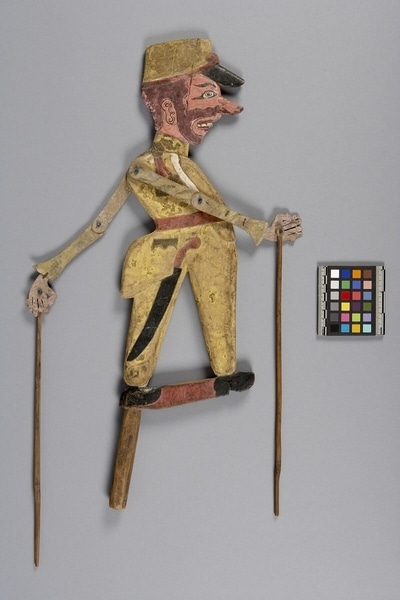Shadow Puppet Item Number: Ib323 from the MOA: University of British Columbia

Description
A two-dimensional male figure puppet with a one-piece wood body carved in low relief. Unpainted wood handle extends below the foot on the left. Leather arms are jointed at the shoulders and the elbows. Wood sticks are attached to the palms to manipulate the arms. Profile body and face are looking to the right. The light red face has a large protruding nose, short hair, moustache, and dark red ring beard. The upper teeth are visible. Wearing a yellow military cap with a black visor, a high-collared yellow uniform, and tasseled epaulette on the left with a light red belt. Pronounced posterior and a long black sword is worn from the hip on the left. The straight legs spread considerably. Red ground is between the black shoes. The hands are bent with a hooked thumb and a protrusion from the finger. Front and back of the figure are identical.
History Of Use
Javanese puppet theatre as an art form probably developed by the 11th century. The form is thought to have originated in southern India; the wayang puppets are indigenous adaptations. Although the prototype wayang kulit puppets are the older form, many symbolic elements remain the same. The shadow plays are performed by a dalang (puppet-master) hired by an individual or group to celebrate important occasions. The performances often last all night and are generally presented in three acts, with vocal and instrumental accompaniment. The individual plays vary widely in detail but usually involve conflict between good and evil. They serve a moral and religious purpose, and more recently, one of political commentary. Each puppet's character is represented by its appearance and placement onstage; protagonists with strong elements of good are placed to the right, antagonists of violent or evil nature to the left. Wayang klikit is a variety of wayang theatre which does not present traditional stories from the Ramayana or Mahabharata epics, uses two-dimensional puppets to offer informational plays about recent Javanese history, current matters of interest and social satire. Wayang perduangan (battle) depicts episodes from Dutch colonial history in Indonesia, rising nationalism, W.W. II and struggle for independence. The style of the uniform suggests that this puppet portrays an authoritative Dutch soldier or policeman during the early part of the 20th century.
Iconographic Meaning
Facial features, colouring, and stance suggest a violent, assertive character in a modern interpretation of traditional symbolism for a contemporary and not mythological figure. A member of the opposing enemy party is represented by negative qualities that would normally appear in the wayang on characters considered evil or ill-tempered. A traditional warrior has been made into a contemporary military figure.
Cultural Context
Theatrical performance.
Item History
- Made in Java, Indonesia
- Owned by Tradewind Antiques before March 15, 1983
- Received from Museum of Anthropology Shop Volunteers (Funding source) and Tradewind Antiques (Seller) on March 15, 1983
What
Who
- Culture
- Javanese
- Previous Owner
- Tradewind Antiques
- Received from
- Museum of Anthropology Shop Volunteers (Funding source) and Tradewind Antiques (Seller)
Where
- Holding Institution
- MOA: University of British Columbia
- Made in
- Java, Indonesia
When
- Ownership Date
- before March 15, 1983
- Acquisition Date
- on March 15, 1983
Other
- Condition
- fair
- Accession Number
- 0886/0057